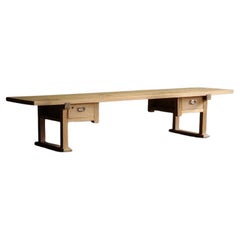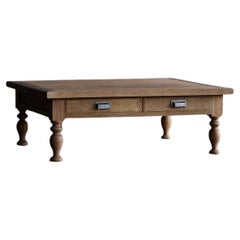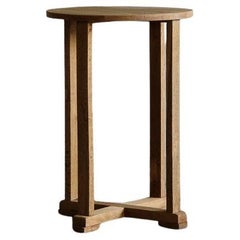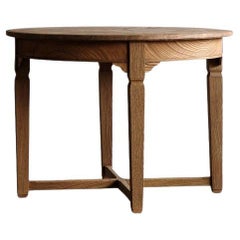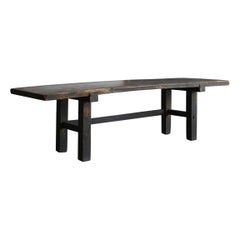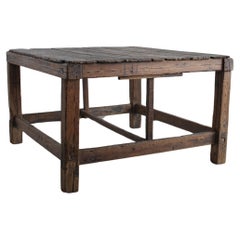Japanese Tables
25
to
2
9
5
25
25
25
1
1
1
9
16
12
2
1
2
1
1
Height
to
Width
to
Depth
to
21
4
3
3
3
12,801
12,794
4,116
3,296
2,689
1
1
1
Place of Origin: Japanese
Japanese Antique Cutting Board Low Table, Taisho Era'Early 1900s', Wabi Sabi
Located in Hitachiomiya-shi, 08
This is a Japanese antique cutting board low table.
It was made in the Taisho Era(1912-1926).
This low table was originally used as a work table...
Category
Early 20th Century Taisho Japanese Tables
Materials
Cedar
Japanese Antique Low Table, Early Showa Period '1926-'
Located in Hitachiomiya-shi, 08
This writing desk, crafted in the early Showa period(1926-) from high-quality Japanese zelkova and oak woods, is a testament to fine craftsmanship. The elegantly turned legs enhance ...
Category
Early 20th Century Showa Japanese Tables
Materials
Wood
Japanese Antique Wooden Display Stand, Early Showa Period '1926-'
Located in Hitachiomiya-shi, 08
Discover the timeless elegance of this display stand, crafted in the early Showa period(1926-).
Its slender, turned legs showcase exquisite craftsmanship, instantly elevating any s...
Category
Early 20th Century Showa Japanese Tables
Materials
Wood
Japanese Antique Round Table, Mid Showa Period '1926-'
Located in Hitachiomiya-shi, 08
This is a round table crafted in the mid-Showa period(1926-).
It is a slightly smaller size.
Made from high-quality, densely-grained Japanese oak, it is both durable and stylish. Its...
Category
Mid-20th Century Showa Japanese Tables
Materials
Wood
Japanese Antique Round Table, Taisho Era'Early 1900s', Wabi Sabi
Located in Hitachiomiya-shi, 08
This antique round table was crafted in the Taisho Era(1912-1926).
It is made from high-quality Japanese zelkova, which has a distinctive reddish hue. The tabletop is a single piec...
Category
Early 20th Century Taisho Japanese Tables
Materials
Wood
Japanese antique wooden small low table/1868-1920/coffee table
Located in Sammu-shi, Chiba
This is an antique wooden low table that was used in rural areas and shops in Japan.
In Japanese, this is called "fu-zukue."
Farmers used it to study, and shops used it to keep track...
Category
Late 19th Century Meiji Antique Japanese Tables
Materials
Wood
Japanese Antique Round Tray / Exhibition Table / 1900s WabiSabi Primitive
Located in Iwate-gun Shizukuishi-cho, Iwate Prefecture
This is an old Japanese round tray.
It's a simple structure, but it has an elegant appearance.
Around 1900, it is estimated that it is from the Meiji period to the Taisho period.
...
Category
Early 20th Century Taisho Japanese Tables
Materials
Wood
James Mont Low Japanese Floor Table in Black Lacquer
Located in New York, NY
Low Japanese Floor Table in Black Lacquer
Category
Early 20th Century Japanese Tables
Materials
Wood, Lacquer
Japanese antique wooden table for wall mounting/Early 20thCentury/Wabisabi table
Located in Sammu-shi, Chiba
"Note"
This is a special table that is placed against the wall.
Be sure to install it in a place where it touches the wall.
This table is made from a combination of materials made f...
Category
Early 20th Century Meiji Japanese Tables
Materials
Cedar
Pair of Vintage Japanese Mother of Pearl Inlaid Rosewood Nesting Tables
Located in LOS ANGELES, CA
Vintage Japanese Mother Of Pearl Inlaid Rosewood Nesting Tables. This item includes restricted materials and can not be sold outside of the co...
Category
Mid-20th Century Chinoiserie Japanese Tables
Materials
Rosewood
Arts & Crafts Japanese Table retailed by Liberty and Co.
By Liberty & Co.
Located in Lee-On-The-Solent, GB
Arts and Crafts ebonised Japanese Occassional Table, retailed by Liberty and co. Time consuming to make, as all carved floral motifs to the table top, bottom shelf and each of the fo...
Category
1910s Vintage Japanese Tables
Materials
Wood
Japanese Lacquer Sewing Table
By G. None
Located in Wilson, NC
Japanese lacquer sewing table, the top and front decorated with words and flowers, the interior fitted with compartments and pin cushions, the box resting on two turned legs with con...
Category
1890s Antique Japanese Tables
Materials
Metal
Liberty & Co Japanese Carved Side Table Art Nouveau
By Liberty & Co.
Located in Norwich, GB
A Japanese fruitwood carved side table, retailed by Liberty & Co. Circa 1900.
These tables were commissioned by Liberty & Co, and hand-carved in Japan. The firm imported Middle Ea...
Category
1890s Art Nouveau Antique Japanese Tables
Materials
Fruitwood
Circa 1905 Liberty's London Japanese Hand Carved Side Lamp Table Cutlery Drawers
By Liberty of London
Located in GB
We are delighted to offer for sale this exquisitely made original circa 1905 hand made in Japan, retailed through Liberty’s London, cutlery table
A ve...
Category
Early 1900s Edwardian Antique Japanese Tables
Materials
Oak
Late 19th or Early 20th Century Japanese Hexagon Shape Marquetry Table
Located in San Francisco, CA
Offered here is a late 19th or early 20th century Japanese marquetry table, with a hexagonal shape top.
Variety of woods was used, and fine detailed c...
Category
Late 19th Century Meiji Antique Japanese Tables
Materials
Wood
19th Century Japanese Meiji Porcelain Garden Seat or Table
Located in Houston, TX
Stunning 19th century Japanese Meiji period hand decorated porcelain garden seat, garden stool or table. This antique Japanese garden seat is bea...
Category
1880s Meiji Antique Japanese Tables
Materials
Porcelain
19th Century Japanese Meiji Porcelain Garden Seat or Table
Located in Houston, TX
19th century Japanese Meiji Porcelain garden seat or table.
Stunning 19th century Japanese Meiji period hand decorated porcelain garden seat, garden stool or table. This antique Japanese garden seat...
Category
1880s Meiji Antique Japanese Tables
Materials
Porcelain
Antique Japanese Plant Stand, Carved Lacquered Lamp Table, Meiji Period, H132
Located in Vancouver, BC
Antique Japanese plant stand, carved lacquered lamp table, Meiji period, Japan 1900, H132
Japan, 1900
Hardwood construction
Original finish
Octag...
Category
Early 1900s Meiji Antique Japanese Tables
Materials
Oak
Japanese Post War Aluminum Riveted Trunk on Iron Stand with Glass Top, Restored
Located in West Palm Beach, FL
Japanese post war aluminum riveted trunk on iron stand with glass top, restored
Stamped TS Tokyo on the lock, at the time of posting we have another trunk and stand LU2592316549342
...
Category
20th Century Modern Japanese Tables
Materials
Iron, Aluminum
Antique Japanese 1880 Elm Side Table on Stand with Ornate Cast Brass Fixtures
Located in GB
We are delighted to offer for sale this lovely original antique Japanese Elm & polished brass chest on stand
A very good looking well made and decorative piece. The chest is an id...
Category
1880s Victorian Antique Japanese Tables
Materials
Brass
Late 19th Century Japanese Zitan Wood Carved Stand in the Form of a Table
Located in Stamford, CT
An Zitan wood low table / stand. Late 19th century Japanese Meiji Period. Zitan is an extremely dense wood which sinks in water. It is a member of the rosewood family. The wood is bl...
Category
1890s Meiji Antique Japanese Tables
Materials
Zitan
19th Century Japanese Wakasa Lacquer Table
Located in Atlanta, GA
A stunning 19th century Japanese coffee or cocktail table in Wakasa lacquer. The Wakasa-Nuri technique is a process of laying 100 plus layers of differe...
Category
19th Century Antique Japanese Tables
Materials
Lacquer
Teruaki Ohashi Table for Inscription
By Teruaki Ohashi
Located in Shibuya-ku, Tokyo
Unique table commissioned for Inscription which individual house was designed by Japanese female architects Itsuko Hasegawa in 1987.
Teruaki Ohashi was designed this one off table f...
Category
1980s Post-Modern Vintage Japanese Tables
Materials
Stainless Steel
Japanese Antique, Low table, Taisho Period'Early 1900s', Wabi Sabi
Located in Hitachiomiya-shi, 08
This is a low table of Japanese antique.
It was made in the Taisho period. (1912-1926)
It was used as a writing desk in Japan, a culture that lives sitting on the floor.
It is equip...
Category
Early 20th Century Taisho Japanese Tables
Materials
Wood
Early 20Th C. Japanese Wabi Sabi Artist Table
Located in London, GB
A rare, heavily patinated cedar table from an artist studio on the outskirts of Tokyo.
Solidly constructed with many age old repairs.
Sympathetically restored in our London wor...
Category
Early 20th Century Japanese Tables
Materials
Cedar
Related Items
Japanese Antique Wooden Low Table / Display stand / WabiSabi
Located in Iwate-gun Shizukuishi-cho, Iwate Prefecture
A exhibition stand made of old materials.
Probably, is the top board a zelkova and the legs an oak.
There is a very valuable wood grain, and it looks like an art created by nature....
Category
Mid-20th Century Other Japanese Tables
Materials
Wood, Oak
Japanese Antique Wooden Table / Exhibition Table Early Showa Period Wabi Sabi
Located in Iwate-gun Shizukuishi-cho, Iwate Prefecture
It's an old table in Japan.
Cedar and pine are used for the materials.
It seems that it was made in a private house in the Tohoku region around the early Showa period.
Although it is a simple design, the Kumite part is assembled with a traditional technique that does not use nails.
The color that changed naturally over a long time and used is very beautiful, and it will complement the decoration as an exhibition table...
Category
Early 20th Century Showa Japanese Tables
Materials
Cedar
H 27.56 in W 71.26 in D 28.35 in
19th C. French Charles X Restoration Period Sewing Stand Work Table
Located in Forney, TX
A scarce period Charles X (1818-1834) French Restoration mahogany travailleuse sewing (thread stand - side table - jewelry dressing table) with light, warm, beautifully aged patina.
Born in France in the early 19th century, almost certainly Parisian work, exquisitely hand-crafted, this exceptionally executed example features ornate gilt bronze ormolu mounts, escutcheons, and elaborate gilt metal trim. Having a highly figured light mahogany hinged lid top, lifting open to reveal a striking finished interior with divided compartments and original inset mirror plate. The conforming rectangular case fitted with a faux drawer front over a dovetailed drawer with sectioned interior. Elegantly rising on oval-shaped medial shelf stretcher-joined curvacious legs.
Dimensions (approx):
27" High, 20" Wide, 13.5" Deep
Stunning light almost blonde antique mahogany coloring and mellow warm tone, superb wood grain detail, and charming, beautifully aged patina over the whole. Great shape overall. Retaining original antique character marks, wear consistent with age and indicative of minimal use, nothing that detracts from the aesthetics or functionality, but only adds to the overall authenticity, refined elegant warmth, luxurious sophistication, and cozy unpretentious rustic elegance.
Delivered cleaned, hand waxed, polished French patina finish, ready for immediate use and generational enjoyment!
What is Charles X style:
The comte d’Artois – or Charles X - was the son of the dauphin Louis-Ferdinand de Franc and Marie-Josèphe de Saxe. He succeeded his two brothers Louis XVI and Louis XVIII and became the King of France in 1824. Thirty years after the French Revolution, he wanted to embody the return of monarchy and became the leader of the catholic party . As the previous kings, he was crowned in 1825 but he was soon overthrown by the revolution in July, 1830, called "Trois Glorieuses". He left then for England, Scotland, Prague and Istria where he died in 1836.
Charles X style lasted from 1818 to 1834 and happened during the Bourbon Restoration (French Restoration). This style did not replace totally the style of furniture from the French Empire but it was different from the formalism in the Napoleonic era, during which strictness and simplicity were inspired by Greco-Roman art. Indeed, artistic fields flourished. In terms of furniture, this renewal was suggested by the softening of shapes. Even though the simple aspect from the French Empire was still visible, shapes became curvier with volutes and arabesques. Another distinction is the loss of the massive aspect of furniture and the decrease of dimensions in order to decorate smaller appartments. Handling ability and comfort were key-words in the making of furniture. Apartments had essential elements such as chests of drawers, big rounded tables in the dining room, desks or secretaries, armoires and even dressing tables, comfortable fainting couches in the living room, small tables, pedestal tables, as well as gondola chairs. The wavy aspect of the latters certainly represent Charles X style the best.
One of the most emblematic features of this style is the use of bois clairs – light woods in warm blond tones - and indigenous woods that are varnished in order to highlight the grains. Bird's-eye maple, ash trees, plane trees, yew trees, beech trees, olive trees and cedar trees were most likely to be used. Indeed, at the beginning of the 19th century dark woods were hard to find. In 1806, the Napoleon’s Continental System was established in order to ruin the United Kingdom by preventing the country from any business with the rest of Europe. Therefore craftsmen had to find alternatives from mahogany which was the most commonly used material at this time. After 1815, the import of wood was even more difficult because of peace treaties and the European political situation, which contributed to the popularity of the bois clairs and indigenous woods. The furniture was often decorated with fine inlays made out of dark wood representing foliage, which contrasted with the veneer. Even though these patterns can look like bronze decorations from the Empire era, they were far more simple and did not represent any military or mythological attributes. On the tables, trays were sometimes made out of marble as in the French Empire, but it was often put aside and inlaid veneer, Verre Eglomisé – a type of glass with a mirror finish –, mirror or porcelain from Sèvres or Paris were more likely to be used.
Decorative elements from the Monarchy were highly appreciated again as they suggested luxury. Indeed, marquetry work was particularly fashionable - Boulle marquetry thrived around 1820 as the works of the Levasseur family can show. In the same way, draperies and trimmings referred to the monarchist splendour. Fabrics were often white – the traditional colour of the Bourbons – or light coloured as oppposed to the typical green from the Napoleonic era.
One of the most symbolic figures from this period of time might be Jean-Jacques Werner (1791-1849), a cabinetmaker who worked for prestigious clients such as the Duchesse de Berry who was Charles’s step-daughter. His works can be seen at the Musée des Arts Décoratifs and at the Grand Trianon in the Palace of Versailles. The duchess’s appartments situated at the pavillon de Marsan and at the Palais de Saint Cloud illustrate Charles X style the best with furniture made out of bois clairs and ornamented with dark wood patterns or fine gold decorations.
Chales X style allows a transition between the sobriety of the Empire style and the abundant aspect of Louis-Philippe style. The gothic style started at this time through the "style à la cathédrale", inspired by religious architecture, which thrived from 1827 to 1830. Indeed, at the beginning of the 19th century, Romanticism put the spotlight on the Middle Ages. Cabinetmakers were not inspired by the medieval furniture but rather by architectural elements of churches and cathedrals. For instance the backs of chairs were decorated with arches shaped like rib and serration. In the same way, before Charles X abdicated, pieces of furniture were made out of dark woods – such as mahogany, which was used again in France – and were inlaid with light wood. Romanticism also influenced the layout of furniture in appartments to suggest movement through a mix of various styles, various shapes and various sizes, as opposed to the static aspect of Neoclassicism. The start of industrialisation and mechanisation also influenced this style as early technical developments led to the production of pieces of furniture in series.
Credit:
Marc Maison
Bibliography:
FANIEL Stéphane (Dir.), Le Dix-neuvième Siècle Français, Collection Connaissance des Arts, 1957, Hachette
SASSONE, Adriana Boidi, Furniture from Rococo to Art Deco, 2000, Evergreen
--
Extremely versatile:
As warm and attractive as it is useful, this remarkable antique table having the ideal size and small proportions for a variety of different uses, including as a side table, accent or occasional table, tall sofa...
Category
Early 19th Century Charles X Antique Japanese Tables
Materials
Bronze, Ormolu
Japanese Antique Low Table/Japanese paper pasting/1868s-1912s WabiSabi Primitive
Located in Iwate-gun Shizukuishi-cho, Iwate Prefecture
This is a low table using old wood and old Japanese paper.
The top board is stacked with old Japanese paper on a pine tree and dyed with persimmon juice, ink, and black Urushi.
Whi...
Category
Late 19th Century Meiji Antique Japanese Tables
Materials
Wood, Pine
H 8.67 in W 33.47 in D 13.78 in
Andrianna Shamaris Wabi Sabi Teak Wood Oval Coffee Table
By Andrianna Shamaris
Located in New York, NY
Beautiful aged teak wood panels joined together with lovely patina and soft rounded edges. Celebrating the cracks and crevices and all the other marks that time and loving use have l...
Category
1950s Rustic Vintage Japanese Tables
Materials
Wood, Teak, Reclaimed Wood
Antique American Early Kitchen Stove Now Console Table
Located in Forney, TX
A charming antique American kitchen range warming oven wood stove converted into a unique table with lots of storage!
Born around the turn of the late 19th / early 20th century, repurposed and fashioned it a one-of-a-kind table (or kitchen island) in the second half of the 20th century, having a divided top fitted with a later pair of glass panels over decorative cast iron burner hot plates, flanking an enameled hard work surface center, over patinated metal frame case fitted with two large cabinet doors featuring etched glass windows, well aged crackle paint and white porcelain pulls, opening to reveal a large and spacious single storage compartment in updated wood finished interior.
The old fashioned wood burning cooking stove with utilitarian rectangular shaped body, sculptural silhouette in early Art Deco taste with simple clean lines, smooth rounded edge and corners, single scrolling decorative element mounted on slated faux vent, rising on four substantial cast metal cabriole legs with stylized decoration. circa 1920
Versatile:
Finished on all sides so it can be placed anywhere in the room. Strong and sturdy, yet lightweight enough to easily move or put away when not in use, ideal size and proportions for a variety of different ways, including as use as a playful card games table, kitchen island, add chopping / cutting board and use as butcher block stand in a home, cafe or restaurant, breakfast buffet...
Category
Early 20th Century Art Deco Japanese Tables
Materials
Metal, Iron
Antique Victorian quality mahogany large round dining table
Located in Ipswich, GB
Antique Victorian quality mahogany large round dining table having a quality large mahogany circular top with a moulded edge supported on a tu...
Category
Early 19th Century Early Victorian Antique Japanese Tables
Materials
Mahogany
Early 20th Century French Art Deco Period Iron and Metal Bistro Table
Located in Fayetteville, AR
This early twentieth century French Art Deco period rectangular bistro table or cafe table features a metal top on a cast iron pedestal base. ...
Category
Early 20th Century Art Deco Japanese Tables
Materials
Metal, Iron
Japanese Antique Wooden Low Table / Coffee Table / 1912s-1926s / WabiSabi
Located in Iwate-gun Shizukuishi-cho, Iwate Prefecture
The top board is chestnut wood, and the legs are single-board lowtable with cedar.
The top board emphasizes the wood grain and expresses the flat surface beautifully and three-dimen...
Category
Early 20th Century Taisho Japanese Tables
Materials
Wood, Chestnut, Cedar
H 13.39 in W 34.65 in D 22.45 in
Japanese Antique Large Low Table 1900s-1940s / Sofa Table Wabi Sabi
Located in Sammu-shi, Chiba
Since ancient times, people have created necessary tools from familiar materials to survive in the severe struggle against nature, inherited them, and nurtured their lifestyle and cu...
Category
Mid-20th Century Showa Japanese Tables
Materials
Wood, Cedar
circa 1900 English Oak Folding Whatnot Display Table Cake Stand Lovely Patina
Located in GB
We are delighted to offer for sale this lovely circa 1910 English oak whatnot display stand or folding cake table
A good looking, decorative and well mad...
Category
Early 1900s Late Victorian Antique Japanese Tables
Materials
Oak
H 36.23 in W 7.88 in D 7.88 in
Japanese Antique Round Tray / Exhibition Table / 1900s WabiSabi Primitive
Located in Iwate-gun Shizukuishi-cho, Iwate Prefecture
This is an old Japanese round tray.
It's a simple structure, but it has an elegant appearance.
Around 1900, it is estimated that it is from the Meiji period to the Taisho period.
...
Category
Early 20th Century Taisho Japanese Tables
Materials
Wood
Previously Available Items
Japanese Antique, Low table, Taisho Period'Early 1900s', Wabi Sabi
Located in Hitachiomiya-shi, 08
This is a low table of Japanese antique.
It was made in the Taisho period. (1912-1926)
It was used as a writing desk in Japan, a culture that lives sitting on the floor.
It is equip...
Category
Early 20th Century Taisho Japanese Tables
Materials
Wood
Early 20Th C. Japanese Wabi Sabi Artist Table
Located in London, GB
A rare, heavily patinated cedar table from an artist studio on the outskirts of Tokyo.
Solidly constructed with many age old repairs.
Sympathetically restored in our London wor...
Category
Early 20th Century Japanese Tables
Materials
Cedar
Japanese Antique Round Table, Mid Showa Period '1926-'
Located in Hitachiomiya-shi, 08
This is a Japanese antique round table.
It was made in the Mid Showa Period(1926-).
This Japanese antique round table features a design that pursues simplicity. The use of lauan for...
Category
Mid-20th Century Showa Japanese Tables
Materials
Wood
Japanese Antique Low Table 1860s-1900s / Sofa Table Primitive Wabi Sabi Mingei
Located in Sammu-shi, Chiba
Very old Japanese primitive style coffee table.
Simple design with a single board on a stump.
Furniture from the Meiji period (1860s-1900s).
It is a s...
Category
Early 20th Century Meiji Japanese Tables
Materials
Cedar
H 13.19 in W 59.65 in D 35.24 in
Japanese Antique, Small low table, Taisho Period'Early 1900s', Wabi Sabi
Located in Hitachiomiya-shi, 08
This is a low table of Japanese antique.
It was made in the Taisho period. (1912-1926)
This low table boasts a compact size that can be used smartly in limited space.
The top panel...
Category
Early 20th Century Taisho Japanese Tables
Materials
Wood, Pine
H 10.87 in W 29.93 in D 11.82 in
Japanese Antique, Oval low table, Taisho Period'Early1900s', Wabi Sabi
Located in Hitachiomiya-shi, 08
This is a Japanese antique oval low table.
It was made in the Taisho Period(1912-1926).
Its smooth curves bring elegance to your space. Although not easy to use, the drawers are con...
Category
Early 20th Century Taisho Japanese Tables
Materials
Wood
H 11.23 in W 29.14 in D 25.4 in
Japanese Antique, Low table, Taisho Period'Early 1900s', Wabi Sabi
Located in Hitachiomiya-shi, 08
This is a Japanese antique low table.
It was made in the Taisyo Period(1912-1926).
The tabletop, made from japanese pine wood, boasts a gentle grain that exudes natural warmth and t...
Category
Early 20th Century Taisho Japanese Tables
Materials
Chestnut, Pine
Japanese Antique, Low table , Taisho Period'Early 1900s', Wabi Sabi
Located in Hitachiomiya-shi, 08
This is a Japanese antique low table.
It was made in the Taisho period (1912-1926).
Made entirely of Japanese zelkova wood, a high-grade material, this table radiates quality at first glance. Japanese zelkova has long been loved for its luxurious texture and durability, and historically stands out as a high-end material.
Its intricate grain and exquisite design add sophistication to any room. The traditional beauty of the turned legs will captivate the hearts of antique fans...
Category
Early 20th Century Taisho Japanese Tables
Materials
Wood
Japanese Antique, Low table, Early Showa Period'1926-', Wabi Sabi
Located in Hitachiomiya-shi, 08
This is a round low table, crafted entirely from zelkova wood. The beauty of the grain, unique hues, and inherent warmth of the material are highlighted to their fullest extent. Zelk...
Category
Early 20th Century Showa Japanese Tables
Materials
Wood
Japanese Antique Primitive Low Table 1860s-1900s / Sofa Table Mingei Wabi Sabi
Located in Sammu-shi, Chiba
This is a very old Japanese low table.
It is from the Meiji period (1860s-1900s).
It was carved from a large zelkova tree.
It is dynamic and powerf...
Category
Early 20th Century Meiji Japanese Tables
Materials
Wood
H 8.86 in W 37.01 in D 35.44 in
Japanese Antique Large Table 1860s-1900s / Sofa Table Coffee Table Wabi Sabi
Located in Sammu-shi, Chiba
Large table in a very old Japanese primitive style.
It is a simple style with a single board on a stump.
The furniture dates from the Meiji period (1860s-1900s).
The top is made...
Category
Early 20th Century Meiji Japanese Tables
Materials
Wood
H 20.48 in W 70.87 in D 29.14 in
Japanese Antique Low Table 1860s-1900s / Sofa Table Coffee Table Wabisabi
Located in Sammu-shi, Chiba
This is a very old Japanese primitive style table.
It is a simple style with a wooden board on top of a stump.
Furniture from the Meiji period ...
Category
Early 20th Century Meiji Japanese Tables
Materials
Wood
H 11.42 in W 40.56 in D 22.84 in
Recently Viewed
View AllMore Ways To Browse
Round Marble Mosaic Table
Marcel Wanders Container
Metal Half Moon Table
Zinc Bistro Table
Grey 140cm Table
Copenhagen Round Dining Table
Stefano Giovannoni For Ghidini
Provincial Rococo Table
Ball And Claw Foot Mahogany Table
Potting Table Bench
Antique Laboratory Table
Cast Iron Pub Table
14th Oak
Specimen Marble Panel
Mid Century Modern Dining Table Extention
Van Rossum
8 Legged Table
Tessellated Travertine Table
